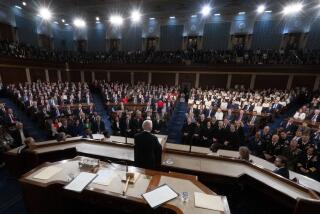PERSPECTIVE ON HEALTH CARE REFORM : ‘Pay or Play’ Is a Losing Gamble : The Democrats would give us the ultimate bureaucracy. There are better ways to improve medical care.
“Pay or play,” a phrase that sounds like a new game in Las Vegas, is the catchy nickname for a health-care reform proposal that has been introduced by Democrats in Congress. Advertised as a simple way to get more people insured, it’s really a back door to national health care, which would be a cumbersome bureaucratic system.
The idea is simple--deceptively so. Under the “pay or play” proposal, all employers would be required to either provide health insurance to their full-time employees or pay into a public health insurance system to be run by the federal government.
Of course, all Americans want a health-care system that works better and provides access to care for everyone. And “pay or play” has garnered a lot of attention because it sounds easy and fair.
But the truth is that “pay or play” would result in the worst of all worlds: closed businesses, lost jobs, huge new expenses for both the private sector and the taxpayer, and an enormous new bureaucracy. It would start us down the road to a nationalized health insurance system and lead eventually to rationing of health care and long waits for medical care--something the American people won’t, and shouldn’t, tolerate.
True enough, this proposal is one way we could expand access to care. But it should really be called “pay . . . and pay . . . and pay some more.”
It would hurt many of those it’s meant to help, including small businesses. It would even result in tens of millions of Americans who are now covered by private health insurance being transferred unnecessarily to a new government-run program; many businesses would opt to drop private insurance and let employees be covered by the government instead, because the government plan, subsidized by taxpayers, would be the cheaper alternative.
Is that the kind of health-care reform we want?
This week, many Democratic members of Congress will be holding orchestrated “town meetings” around our nation. The idea is to highlight the health-care issue. That’s fine--except that they’ll be promoting the “pay or play” scheme. And it is unlikely that both sides of the story will be told.
Fortunately, the Department of Labor released an independent study of “pay or play,” last Thursday, done on contract by the Urban Institute and RAND Corp. It estimates the real effects that “pay or play” would bring about, and it is an eye-opener.
Based on the 7% payroll tax proposed in leading Democratic bills, the study finds that:
-- The public plan would grow to cover 112 million people, or more than half of our non-elderly population. It would be more than three times the size of Medicare.
-- Fifty-two million people now covered under employer-sponsored plans would lose their private coverage as employers chose to pay the new tax rather than maintain private insurance. More than one-third of those who now have employer-supplied private insurance would be shifted to the government-run plan.
-- Employers would incur new costs of almost $30 billion. The burden would fall especially on small businesses. For many, this would simply mean closing shop--and eliminating jobs. Small businesses employ more than half of Americans in the private work force.
-- Even with the new tax on payroll for employers who chose it, the vast new public plan would cost more than that tax would bring in. Therefore, an additional $36.4-billion subsidy would be borne by the general taxpayer. The new plan would represent a 131% increase over spending on the current public programs it would replace, notably Medicaid.
If “pay or play” sounds like a gamble, it is. It’s an unnecessary, high-cost gamble with our economy, our small businesses and our health care.
America has set the world standard in medical care. No reform proposal should put that accomplishment in jeopardy. The fact is, we already spend more on health care than any other nation--about $2,600 per person per year. What’s needed is to spend those dollars more effectively--to get better care and better health for the money we’re already committing.
The Bush Administration is developing a comprehensive reform proposal. Our plan will not be simplistic, because the problems are not simple. They vary from inability to buy private insurance at a reasonable cost, to inflexibility in public programs, to outright unavailability of services in some areas. We need a balanced package of reforms that treat a variety of problems while addressing the root causes of waste and inefficiency in our system.
We need to make private health insurance more affordable and more available, especially for small businesses. We also need to ease the barriers to coordinated care plans which can deliver high-quality care at lower cost. We need to support research into what really works, in order to avoid wasteful treatments.
We need to look at incentives, including our tax code. How can we reward cost-effective choices by both professionals and patients? Are the subsidies we provide for health care today as fair as they should be?
We need to upgrade and expand our primary health-care system. Timely and less expensive primary care can often mean emergencies and costs avoided later on. And, of course, we need to encourage healthy behavior and choices by individuals. No single action can improve our nation’s health status more than this one.
America needs reforms that preserve quality of care, improve access and control costs. Our health-care system doesn’t need to gamble on “pay or play.” It needs to “perform.”
More to Read
Sign up for Essential California
The most important California stories and recommendations in your inbox every morning.
You may occasionally receive promotional content from the Los Angeles Times.










